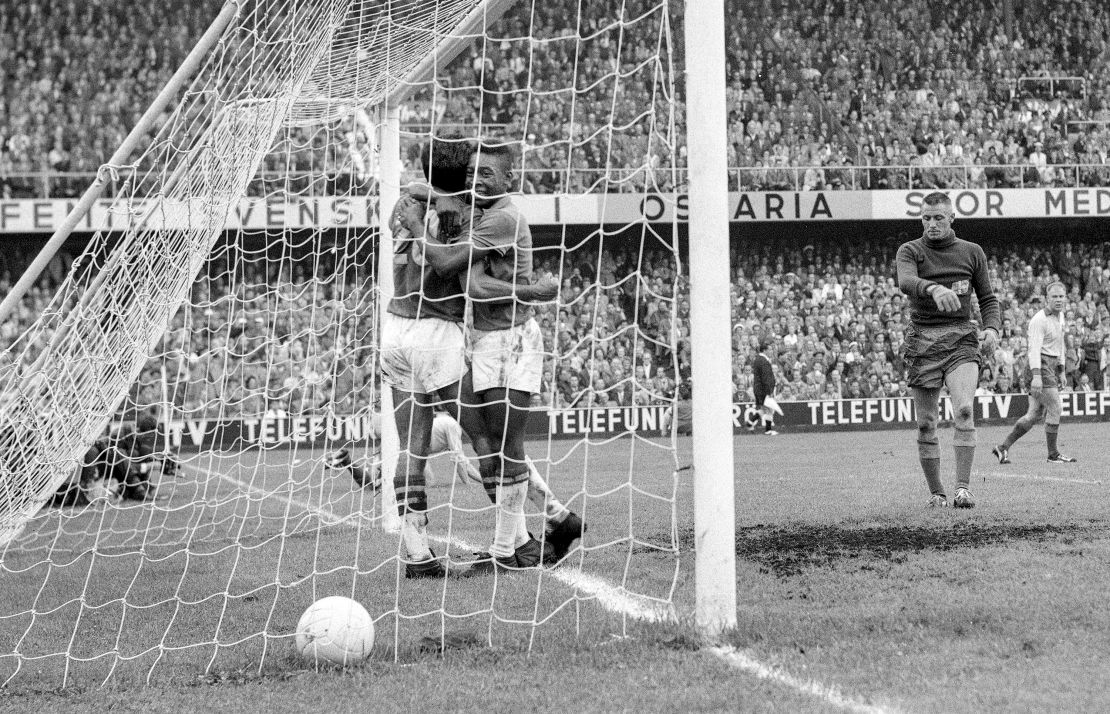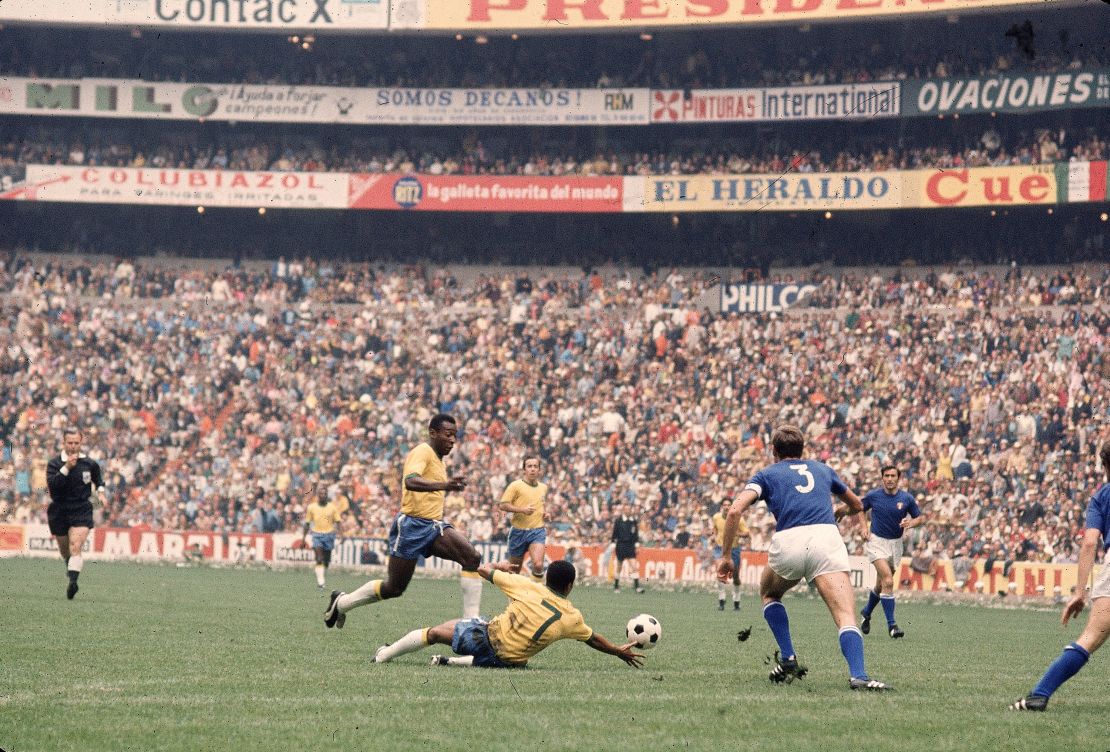Pelé: What made Brazilian legend so great

CNN
—
Born into poverty – he used to kick a grapefruit in the Brazilian state of Minas Gerais – Pelé finished his career as arguably the greatest football player of all time.
He was so rare; like Muhammad Ali, Pelé was a sports star, who transcended his sport.
The Brazilian brought joy and creativity to a sport often mired in rigidity and embodied o jogo bonito – “The beautiful game.”
“Pelé changed everything,” wrote current Brazilian international Neymar Jr. after the announcement of Pelé’s death.
“He transformed football into art, into entertainment. He gave voice to the poor, to black people and above all. It gave visibility to Brazil.
From dazzling at the age of 17 in 1958, on his way to his first World Cup success, to winning the Golden Ball as a player in the 1970 World Cup then that he won a third world title, “O Rei» (“The King”) achieved almost everything possible in the famous yellow and blue of Brazil.
And there were goals – lots of them.
Pelé has scored 757 goals in 812 official matches for club and country. However, there is disagreement over the number of goals he has scored in his career. According to Reuters, the Brazilian football federation and Santos claim that Pele has scored 1,283 goals in 1,367 matches, although FIFA puts the figure at 1,281 goals in 1,366 matches.
But it wasn’t just the phenomenal number of goals he scored. As Neymar suggests, Pelé was also an artist on the pitch.
“Even though he didn’t use a brush or a pen, but just had a ball at his feet,” says CNN Sport’s Don Riddell.
The world got its first glimpse of Pelé during the 1958 World Cup.
“When we arrived in Sweden, no one knew what Brazil was. They know Argentina… Uruguay. It was a surprise for us,” Pelé told CNN in 2016.
At the age of 17 years and seven months, Pelé became the youngest player to appear in a World Cup, a record the Brazilian held until Northern Irishman Norman Whiteside took the record in 1982.
Nearly 15 years after leaving the world emotional during the 1958 World Cup, Pelé hung up his boots for the Selectionleaving his nation the legacy of the most successful team in World Cup history and the most feared team in international football.

Pelé’s crowning achievement for Brazil came at the 1970 World Cup in Mexico, a tournament further romanticized by being the first World Cup broadcast in color.
Throughout this tournament, Pelé blazed a trail of technicolor splendor, a blur of yellow and gold, seducing and mesmerizing opposing teams.
His four goals earned him player of the tournament honors, capped by an assist on Carlos Alberto’s stunning goal in the final against Italy.
“We won the World Cup, and I think in my sporting life (it was the pinnacle), without a doubt,” Pelé told CNN.
Italian defender Tarcisio Burgnich summed up Pelé’s superhuman genius well: “I said to myself before the match, he is made of skin and bones, like everyone else. But I was wrong.”

Even the moments when Pelé didn’t score helped cement his legendary status – notably England goalkeeper Gordon Banks’ incredible block on the Brazilian’s powerful header during a group match, which is widely regarded as the greatest save all time.
“The save was one of the best I have ever seen – in real life and in the thousands of matches I have watched since,” Pelé wrote in a 2019 Facebook post tribute to Banks after the death of the goalkeeper.
“When you’re a footballer, you know straight away how well you hit the ball. I hit that head exactly as I had hoped. Exactly where I wanted it to go. And I was ready to celebrate.
“But then this man, Banks, appeared before my eyes, like some kind of blue ghost.”
Although he played all three years of his club career with Brazilian side Santos, Pelé’s dynamism, majesty with the ball and lethality in front of goal allowed him to become one of the first stars black football worlds.
Pelé admitted on CNN in 2015 that he had a lot of interest from Europe to cross the Atlantic, but he chose not to do so out of loyalty and “love” for Santos; Yet another reason why he is so loved in his native country.
“In the past it was a job full of love, now it’s just a job,” Pelé said.
“There’s not that love of playing for my club, of playing for my country. It is clear that a footballer must make a living from the game. It is different from my time.
Such was his impact as a footballer that Pelé also became the symbol of a new country, according to a recent Neflix documentary.
“To deal with that, I think he creates this character of Pelé, someone who almost sort of gives up his own identity to essentially become Brazil,” Ben Nicholas, co-director of the documentary, told CNN on the life of the Brazilian.
As well as shouldering the burden of a country’s aspirations on the world stage, the arrival of the Brazilian army in 1964, which demonstrated its interest in football as a tactical and political strategy – particularly targeting the 1970 World Cup as a “question of government” – posed a problem for the apolitical Pelé, according to the Netflix documentary.
“There’s a very telling line at the end of the film,” said the documentary’s other director, David Tryhorn, “where you expect Pelé to maybe give us a ‘Pelé-ism,’ where he would speak of joy and happiness, but he actually speaks of “relief”.

The debate over football’s GOAT will rage until the end of time – is it Pelé? Or is it Diego Maradona? Or Lionel Messi or Cristiano Ronaldo?
But Brazil’s pure love and adoration for Pelé cannot be matched and extends far beyond just being a great footballer, but to becoming a totem for a nation.
Sports





